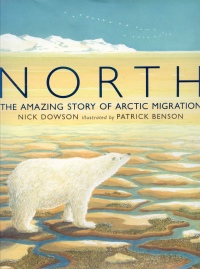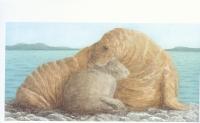| ________________
CM . . . . Volume XVIII Number 32 . . . . April 20, 2012
excerpt:
Nick Dowson’s North: The Amazing Story of Arctic Migration does not depict the North Pole as the home of cozy workshops where little men make toys; rather, the Arctic is “a huge wild place… like an ice desert” (4-6). However, as spring approaches, new life grows and animals make their way there. North follows the journeys of 10 creatures as they travel north for summer.
Benson’s first illustrations in the book capture the barrenness and stillness of the Arctic winter, but the tempo of the illustrations increases and varies as creatures begin their northward migrations, as a variety of birds swoop and dive and caribou trudge through the snow. Benson has a remarkable talent, not only for infusing a sense of movement in a still picture, but capturing the speed and the way an animal moves: the caribou hunch their bodies forward, ever pressing against the harsh winter winds, as they make their long, hard trek (26-27). The illustrations in this book are able to convey a sense of lyricism that the fact-based text does not. North is written as an information text, rather than fiction, but the words are arranged on the page as if they were poetry. When read, the text lacks the rhythm, rhyming and flow that are common in children’s poetry. It feels a bit disjunctive to be reading sentences that are split up into so many lines: “They come because they know/ there will lots to eat /and space to feed and breed / and roam in” (11). This fragmentation is due in part to the confinement of the text to a boxed off section of the page spread. To cause further confusion, Dowson capitalizes phrases, for example, “SOME OF THE FIRST TO LEAVE/ ON THEIR JOURNEY/ are grey whales” (12), that are meant to indicate the start of a new section of the book, but can feel a bit arbitrary and detract from the monumentality of the journeys undertaken by the creatures. At times, Dowson chooses a tone and phrasing that implies a younger audience; yet, as the book continues, it is clear that its sophisticated themes are intended for more intermediate readers. The book presents an impressive number of facts about each creature, ranging from feeding habits to geographical habitats. North does not shy away from the harsh realities of life: “Gray wolves slink after them, /watching for weakness,/ hoping a lame one might/ make a meal” (29). For its factual presentation, this book would make a wonderful classroom tool; however, the focus on cramming as many facts as possible into the story detracts somewhat from its read-aloud-ability and flow. North, however, would be perfectly suited for use in a classroom environment with its range of animals and fact-focused text. At the back of this informational text, Dowson has included a fact page, “About the Arctic,” as well as a glossary and index. This book would be a valuable addition to a nonfiction collection for children in the elementary grades. Given the implications of climate change on the Arctic, North could be used to spark conversations with children about the interconnectivity and cyclic patterns of nature. Recommended. Sabrina Wong is a MLIS candidate at the University of British Columbia.
To comment
on this title or this review, send mail to cm@umanitoba.ca.
Copyright © the Manitoba Library Association. Reproduction for personal
use is permitted only if this copyright notice is maintained. Any
other reproduction is prohibited without permission.
NEXT REVIEW |
TABLE OF CONTENTS FOR THIS ISSUE
- April 20, 2012.
AUTHORS |
TITLES |
MEDIA REVIEWS |
PROFILES |
BACK ISSUES |
SEARCH |
CMARCHIVE |
HOME |

 It is clear that Dowson and Patrick Benson, the illustrator, have created this book in a collaborative manner as the book’s illustrations complement and contribute to the story being told. Patrick Benson’s marvelous illustrations use watercolour, pen and pencil to bring to life the migrating animals. His action-filled double page spread of jaegers and terns fighting over food (20-21) is one of the most exciting parts in the entire book. The impact is heightened by the lack of text on the spread since it forces the reader to narrate the action between the fish, terns and jaegers.
It is clear that Dowson and Patrick Benson, the illustrator, have created this book in a collaborative manner as the book’s illustrations complement and contribute to the story being told. Patrick Benson’s marvelous illustrations use watercolour, pen and pencil to bring to life the migrating animals. His action-filled double page spread of jaegers and terns fighting over food (20-21) is one of the most exciting parts in the entire book. The impact is heightened by the lack of text on the spread since it forces the reader to narrate the action between the fish, terns and jaegers.